History of Cominos House. Arts and Environment Centre.
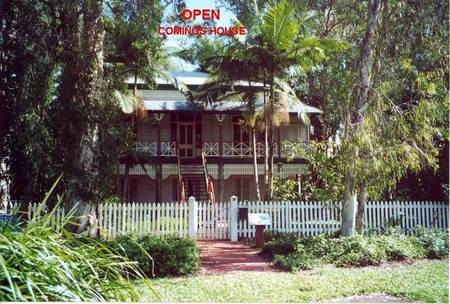
From:
http://cwpp.slq.qld.gov.au/cominos/removal.htm
http://cwpp.slq.qld.gov.au/cominos/history2.htm
Cultural Hub of Cairns
Donation of Cominos House
REMOVAL OF BUILDING TO PRESENT SITE 1988
"Cominos House", built in the late 1880’s, was under threat of demolition when its site on the corner of Abbott (104 Abbott St.) and Florence Streets was scheduled for redevelopment in 1988.
The Cominos family offered the house to Cairns City Council for relocation during the early 1980's . The Council refused the offer due to concerns expressed about presence of infestation in the old timber. However, following Council elections, Mr. Peter Cominos suggested to the purchasers of the property ( Girvan/Mur) that it should be offered to the new Council under Mayor Keith Goodwin, for relocation. The Council quickly accepted the donation which resulted in the house being moved to the present location, here in Greenslopes Street on 1 October 1988.
Cairns House Relocators moved the house to the corner of Little and Greenslopes Streets at a cost of $3,000.
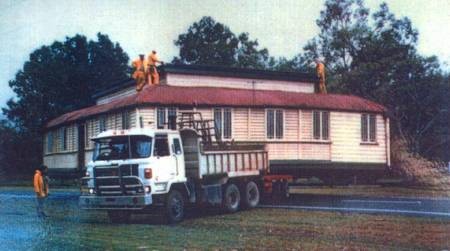
Cominos House - on the move
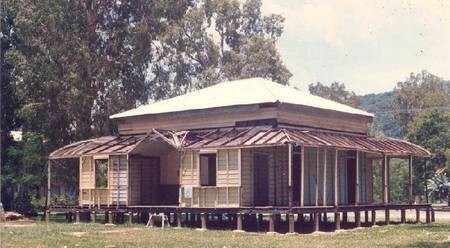
Delivered to Greenslopes Street
The Cominos Family donated an amount of $100,000 towards the re-establishment and maintenance costs of Cominos House in Greenslopes St., on the condition that it was for the use of community groups.
RESTORATION OF BUILDING:
Elevation and floor plans
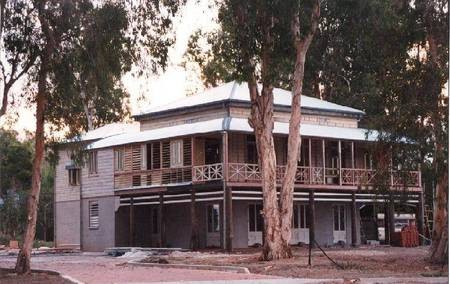
Elevations to Greenslopes Street
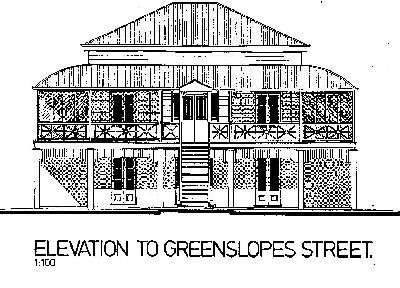
Cominos House. Floor Plans. Note that the centre of the building on the right hand side, has provisions for "clear glass cases for the display of historical artefacts and associated memorabilia".
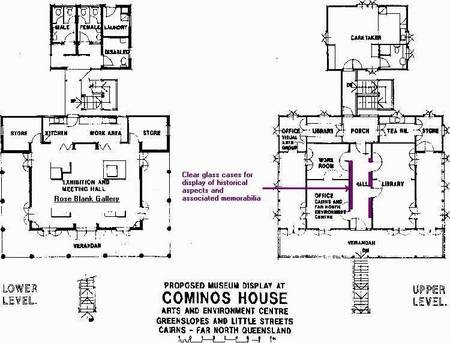
Elevation Plans. Side view
At a Council meeting held in July 1988, a motion to restore the building, initiated by Mayor Keith Goodwin and Alderman Rose Blank, was accepted on the following basis:-
AIMS & OBJECTIVES
To conserve one of the oldest surviving houses in Cairns, previously owned by pioneering and respected Cairns families.
Friends of Cominos House to be a group of people who share a common interest in the conservation to form an Arts and Environment Centre known as Cominos House, located at the corner of Little and Greenslopes Streets,Cairns.
To secure funding and sponsorship and voluntary contributions for Cominos House Arts and Environment Centre.
To conserve, by way of adaptation, an early Cairns residence of historical and social value in accordance with the Australian ICOMOS Charter for the Conservation of Places of Cultural Significance (The Burra Charter)
To complement the existing landscape of the surrounding site with appropriate species.
To adopt management plans and agreements for the occupancy of the centre.
To instigate a program for the maintenance and development of the centre in conjunction with Cairns City Council
To promote the Cominos House Arts and Environment Centre.
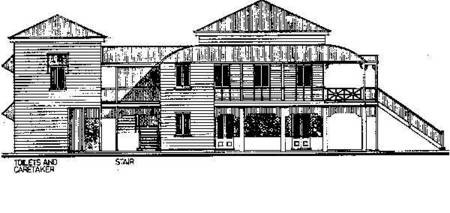
Cominos House Cairns Restoration - Stage One
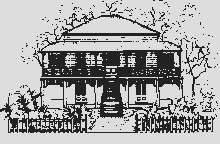
Cominos House Cairns Restoration - Stage Two
29 April 1989 -Cairns City Council called for Expressions of Interest from community groups in Cairns for use of the building. Council accepted those received from the Cairns Art Society on behalf of the Visual Arts Association of Far North Queensland (in formation) and Cairns & Far North Environment Centre, as umbrella organisations for a large variety of community groups.
13 August 1989 – A public meeting with over 50 people attending at the Greenslopes St. site agreed to appoint a Steering Committee to co-ordinate incorporation of "Friends of Cominos House" - a management body to administer the project.
30 August 1989 – The Inaugural Friends of Cominos House meeting was held and it was decided that membership should include representation from Council, The Visual Arts Association and The Environment Centre. An architect, engineer, building consultant, landscape architect, electrical engineer and interior designer would provide specialist advisory services on an honorary basis.
31 August 1989 – March 1991 –The Cominos House Management Committee met frequently during the course of the building restoration to monitor all aspects of project development, and the Council supervised the work. Funding was provided by the Council ($95,000), The Federal Government (World Heritage Grant for Displaced Timber Workers- $48,648* ) and the Queensland Government ( Heritage Grant-$50,000). In addition, there was very generous community support in form of reduced or cost-free materials, labour and services from businesses, trades and suppliers (estimated value approx. $150,000).
*(From Heritage Grant Records)
2 March 1991 – About 140 people attended a celebration of the official opening of "Cominos House - Arts and Environment Centre" by the State Minister for Environment and Heritage, Pat Comben and Cairns Mayor John Cleland, jointly. "Friends of Cominos" was firmly established as the management entity.
Total cost of Cominos House
(Council records 8 April 1992)
Dept of Environment & Heritage..................... $ 50,000
World Heritage Grant.. ........... $ 48,457
Cominos Contribution. $ 74,743
Cairns City Council..... $ 95,000
Donations etc.. $ 170,709
TOTAL. $ 438,909
In addition, there was very generous community support in form of reduced or cost-free materials, labour and services from businesses, trades and suppliers (estimated value approx. $150,000)*.
*(From Heritage Grant Records)
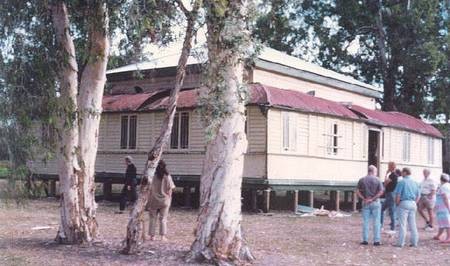
Cominos House relocated. Drawing
QUEENSLANDER – A HOUSE FOR THE TROPICS
The hot and humid climate of tropical Australia has given birth to a characteristic type of wooden house, commonly known as the ‘queenslander’.
The basic structure of the house is a wooden frame erected on round timber stumps, sometimes up to 2 –2.5 metres above the ground. The elevated position provides the house with more breeze and better ventilation, doubling the living space as well as helping the occupants escape flood waters, termites, mosquitoes and snakes.
The steeply pitched roof of corrugated iron with a system of vents allows hot air to be expelled, while deep verandas provide shade and privacy.
Although Queenslander houses differ in size, the basic space layout is similar, with a central corridor providing access to living and sleeping rooms. The kitchen is usually located at the rear of the house, separated from the main house by a small covered veranda. This served two purposes: to keep the heat and cooking smells out of the rooms as well as providing some degree of fire separation from the main part of the house.
These light-weight houses were easy to move, some of them having been relocated two or three times as old settlements died away and populations shifted to new places.
COMINOS HOUSE AS AN EXAMPLE OF
A QUEENSLANDER
Cominos house is a typical example of a middle-class residence from the end of the 19th century. Originally, it stood at the corner of Abbott and Florence Streets, on a site which today is occupied by the Holiday Inn.
A four-roomed house with a centrally positioned corridor, it is surrounded on three sides by deep verandas. Initially the house had a detached kitchen but it was in too poor a condition to be relocated to the present site. However, the caretaker’s flat and the roof linking it to the house replicate the form of these lost parts.
Subsequent users modified the original plan of the home, adjusting the space to their personal needs. Major changes occurred in the early 1930s when all verandas were enclosed with wooden louvres and coloured glass windows to provide security and additional living space, while the backyard toilet was replaced with an in-house facility. The dirt space underneath the house was used as a laundry and storage area, although at one stage (early 20th century) it was used to give private tuition classes to a small group of children.
At this stage of research we cannot determine whether Cominos House is one of the pre-fabricated, light-weight houses shipped to Cairns from more developed centres in the south, or whether it was constructed of local timber.
THE FIRST OWNERS
ALFRED AND ANNIE STREET
For the first 45 years (1877-1922) the property belonged to the family of Alfred and Annie Street who rented it to a number of tenants.
Alfred Street, a builder by profession, arrived in Cairns with the first group of settlers in 1876. Records indicate that the following year his wife, Annie Street, purchased a large block of land on the outskirts of the then village of Cairns, on the corner of Abbott and Florence Streets. Sometime between 1877 and 1886 a queenslander house was erected on the block.
Alfred Street was very active in the social and political life of Cairns, having been elected as an alderman of the first Cairns Council. He was also a member of the committee for the first state school in Cairns which opened in 1887.
On the business side, he was a pioneer of the coffee industry in northern Queensland and owned the coffee plantation ‘Fernhill’, situated on the banks of the Barron River near Kuranda. His coffee, marketed under the name ‘Barron Falls’, won many prizes at local shows as well as in Paris and London.
THE TENANTS
During the years 1886-1922 the house was occupied by a number of tenants, many of whom contributed to the development and growth of Cairns. The first recorded tenant was Mrs A. Liddle who during the years 1886-88 ran it as a private boarding house. The longest tenant was Arthur Mears, an insurance agent, who lived in the house for almost 10 years
(1901-1910). Another tenant was William Lennon – a local grocer and draper.
The most well-known identity who occupied the house between 1893-92 was Robert Sturt, an auctioneer and commission agent, who facilitated the sale and lease of many properties in Cairns at the turn of 19/20th centuries. He was also a member of the Cairns Chamber of Commerce and was instrumental in establishing the Harbours Board for Cairns. When Cairns Stock Exchange opened in May 1906, Robert Sturt was given the position of Treasurer.
As acknowledgment of his contributions, Sturt Street in the Westcourt suburb was named in his honour.
THE FORBES FAMILY
Following the death of Annie Street in 1921, the property was subdivided and the land with the house was sold to William McDonald Forbes, who lived here with his family until 1927.
The Forbes were one of the most prominent families of Cairns at the turn of 19/20th centuries. William’s father, John, worked as customs officer in Cairns between 1895 –1903 and is remembered for leading the Federation of Australia parade in Cairns in 1901.
William MacDonald Forbes worked as the manager of the firm ‘Joseph Pease Wholesale Merchants’ in Cairns, which specialised in the local distribution of spirits.
HOUSE FOR THE COMINOS FAMILY
On his return from Greece, George Emanuel Cominos needed a comfortable house for his growing family and so in 1927 he bought the Forbes’ house for £1,255 which was then a very significant amount of money. It served as a home to his family and relatives for almost 40 years, until its relocation to the present site.
George and Bylio Cominos had three children: Emmanuel George who completed a degree in science and education to work as a teacher; Peter George – a well-known Cairns pharmacist, and a daughter Toula who helped with running the family café and later with management of her brother’s pharmacy.
When the children were young and George spent long hours working at the café, various relatives were invited to stay at home helping with odd jobs and to provide some protection. In 1930 Georges’ mother moved from Greece to stay with them. Most of the time Greek was the language spoken at home and on special occasions and gatherings Greek music was played.
Following the death of George in 1962, Bylio continued to live at the house during the day receiving her relatives and friends, while for the evening and night she used to move to the nearby house of her son Peter.
In 1977, when she passed away, the house was closed up until 1986 when the property was sold and the house was moved to its current site.
COMINOS CAFÉ: THE CAIRNS’ LEGEND
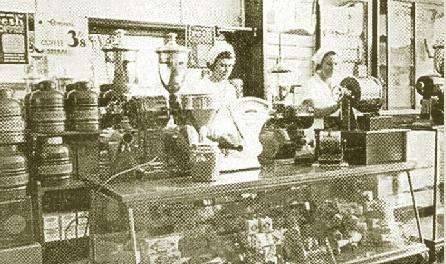
Coffee Sales Cominos Café
For several decades, Cominos Café acted as the social hub of Cairns and nearby towns. Established in 1906 as a small catering business, it grew to become one of ‘Australia’s most modern cafés’, which at one stage employed over 100 people.
For most of the time the café was situated in Abbott St, on the site of today’s ‘Orchid Plaza’ shopping centre. It occupied two floors with a mezzanine area and provided its customers with high quality food and drinks as well as with a range of services appreciated especially by country clients on visits to Cairns: showers, toilets and rest rooms.
Cominos was a ‘departmental’ café: it had a cake counter, sandwich counter, milk bar, sweets counter as well as a bakery. George Cominos paid the utmost attention to all details creating a relaxing and welcoming atmosphere: cages of birds placed all over the café entertained the customers!
The place was well-known far beyond Cairns for the high standards of food and services as well as for the progressive ideas of its owner. For instance, in 1935 George Cominos installed in the bakery the first electric industrial oven in this part of Australia.
The café served as a venue for many big social functions such as wedding receptions, as well as a rest place for visitors to Cairns. During the Second World War it became a favourite meeting place for Allied service staff based in Far North Queensland.
In 1952, due to declining health, George Cominos decided to close the Café. However even today the legend of ‘Cominos Café’ lives on in the fond memories of many Cairns residents.